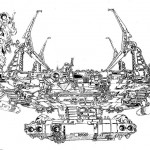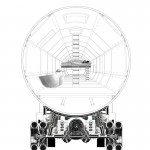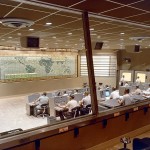Think Space, an international, public, anonymous, single stage, conceptual architectural – urbanistic design competition, (to which we participated twice: 1–2, as a practice), founded in 2010 by the Zagreb Society of Architects and open both to professional and students of architecture, returns this year with a special edition entitled “THINK public SPACE“.
The theme of “publicness” will be the subject for a series of conceptual ideas, papers, thoughts on public space “beyond cultural, geographic or institutional borders“.
Devised in collaboration with the City of Zagreb, the project “Zagreb for Me” is a comprehensive project for the revitalization of the city’s public spaces, through 17 architectural and urbanistic interventions (both in a theoretical and conceptual level) and the exploration and questioning of the character of public space in present-day social, geo-political and economical context.
Following is the Theme from the Competition Brief
Cities around Europe are grounds of ever intensifying conflict between two paradigms. On the one hand side we are witnesses of urban development as an infrastructure of global capital, and on the other hand side the traditional idea of maintaining the concept of a city as a political place in which sovereignty thrives on public squares. While the first paradigm sees the private interests necessarily transform into public ones, the other looks upon public sphere as the last defensive line against gentrification. Architecture, in this case acts as a discipline providing the spatial and physical framework for this conflict of interests in public space.
We are happy to promote the initiative of ours pals in Zagreb, since many of the previous years results have been of great quality. One of them is the 2013 ex-aequo winning project by Aristide Antonas, (also a juror for this year edition), in collaboration with Mara Bitrou, Panos Demiris and Katerina Koutsogianni, entitled “The Weak Monumental Square”. A cheap scaffolding structure forms the limits of a monumental open space in Athens, obtained through the demolition of a poor architectural intervention of the 1980’s and thus ‘excavated as a new archaeological field‘. The open area will show what is is usually hidden in the ground of the modern city: its subterranean infrastructure (sewage, tubes and electric cable), and will host a number of concrete tables empowered by the city’s electricity network and by Internet capability.
The new open space of Koumoundourou will be the first in the city with a homogenous design, the first undertaken after the city’s bankruptcy.

Urban MONUMENT BY DEMOLITION (Aristide Antonas – 2013)
The Weak Monumental Square is a project undertaken in Athens after the city’s bankruptcy. It deals with the new condition of the city center. We could schematize in a new brief the area of the very center of Athens as a multistoried field that in the new condition needs to accept that it became already sparse; at the contrary of the city’s past the city no longer condenses paradigmatically its vivid mediterranean side in the center. A dense field of an unused infrastructure offers some of its enclosed spaces to a different public sphere that could be under construction. A strategic decision or redistribution of these empty spaces could rebuild anew a different attitude to the modern ruins that host the city. They can be visitable again through different architectures; intervening to the private sector which is anyway destroyed could be a public task. Architecture could have as a role to re-elaborate the public sphere as a new, different urban scene.

We challenge here the possibility of a monumental character (always in action in the city of Athens) through demolishing and scaffolding. We emphasize the creation of a vast linear square in a part of the city center that was originally privileged (from the first modern Athens plan by Kleanthis and Schaubert) in order to host an important public space of the city. The axis was constructed as Koumoundourou square only at the south of Piraeus street. Nevertheless this square is semi built and suffers now from a late 80s intervention that transformed it into a mediocre park. We propose an extended demolition at the north of Koumoundourou square in order to unify it to another unshaped open space towards Metaxourgeio area, Avdi square. The new impressive scale of the piazza will give to the city one of its new emblematic open spaces. Athens being constructed as a series of micro-expansions of the city plan lacks this urban scale.

The new open space of Koumoundourou (both the existing part and the new) will be excavated as a new archaeological field. A part of the ancient city is buried under the modern city surface. Nevertheless we do not act as typical archaeologists. The infrastructure of the existing modern city will keep its place at the new square, it will show together with the idealized ruins a hidden part that any modern city hides in order that its normality is guaranteed: parts of the sewerage system, water tubes and protected electricity cables. Our archaeology will bring to light and restore the hidden ground of this idiosyncratic locality. Furthermore: the infrastructure will be able to host a large number of concrete tables empowered by the city’s electricity network; they will be lighten and provide safe power plugs. Some stations of the telecommunication network will provide free wireless Internet. An underground passage unifies the two sides of the square connecting the two sides of Piraeus street.

A system of scaffolding forms the limits of the new open space. It has the dimension of a shipping container. It forms a system of terraces for the owners of the flats in front of it. When its rigid geometry does not support any neighboring extension of an apartment it forms a new urban land that is capable of supporting a small office for non permanent use or a public terrace. The scaffolding system is covered by a semi transparent material. Even if the material is so cheap the monumental impression of the ensemble is guaranteed. Athens has no homogeneously designed square, this will be its first one.

The area where the intervention is proposed is one of the most delicate in central Athens. The next blocks form the first beginning of a growing athenian chinatown. Very near a neighborhood of Roma is settled. But Metaxourgeio is also becoming an area with includes fancy expensive restaurants and new real estate strategies. An extensive open space of this size will help any possible evolution.
All the images and the introductory text of the Antonas’ project are © Aristide Antonas.
For more information about Antonas, read this wonderful monography curated by our dear friend Luca Galofaro, and ‘Archipelago of Protocols‘ published and curated by our friends as well at Dpr-Barcelona. More on Socks.





Leave a Reply